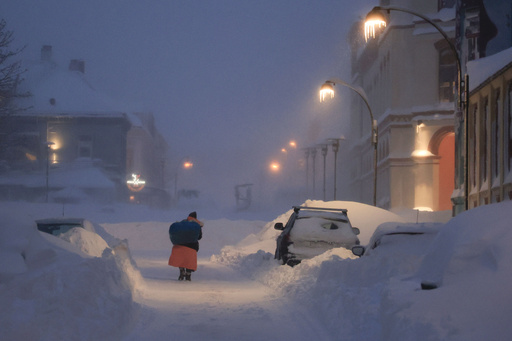
People fight their way through the snowstorm in Kristiansand, Norway, Wednesday, Jan. 3, 2024. Temperatures below minus 40 degrees Celsius (minus 40 Fahrenheit) continued to be recorded in the Nordic region with a 25-year-old record for January night being recorded in the Swedish Arctic as a cold spell continued to grip the Nordic region. (Tor Erik Schroder/NTB Scanpix via AP)
COPENHAGEN, Denmark — Europe experienced stark weather contrasts on Wednesday, with extreme cold and snowstorms disrupting transportation and closing schools in Scandinavia while strong winds and heavy rain in western Europe caused flooding and at least one death.
Temperatures fell below minus 40 degrees Celsius (minus 40 degrees Fahrenheit) in the Nordic region for a second day in a row Wednesday. In Kvikkjokk-Årrenjarka in Swedish Lapland, the mercury dropped to minus 43.6 C (minus 46.5 F), the lowest January temperature recorded in Sweden in 25 years, Sweden’s TT news agency reported.
Extremely cold temperatures, snow and gale-force winds disrupted transportation throughout the Nordic region, with several bridges closed and some train and ferry services suspended. Several schools in Scandinavia were closed.
Police across most of Denmark urged motorists to avoid unnecessary trips as wind and snow battered the northern and western parts of the country.
The wave of cold air from Siberia and the Arctic region has also swept down over western Russia, with temperatures in Moscow and other areas plummeting to minus 30 degrees Celsius (minus 22 F), well below the average temperature for early January.
Officials in Moscow, St. Petersburg and other areas have issued orange weather warnings, cautioning residents against possible health risks.
Holiday homes at the Billing Aquadrome in Northampton are surrounded by water caused by Storm Henk on Wednesday, Jan. 3, 2024. A severe flood alert, meaning danger to life, was in place for the River Nene in Northampton, which warned of deep and fast-flowing water at the Billing Aquadrome holiday park and nearby business parks. (Jacob King/PA via AP)
Mild but wet and windy conditions prevailed further south, where a storm wreaked havoc in parts of western Europe.
In Britain, a driver died after a tree fell on his car in western England. Gloucestershire Police said the man died in the incident near the town of Kemble on Tuesday afternoon.
The storm, which has been named Henk by the official weather services of Britain, Ireland and the Netherlands, has caused power cuts, transport troubles, property damage and disruption across the U.K.
More than 300 flood warnings were in place across England and Wales on Wednesday, while 10,000 homes remained without power. A severe flood alert, meaning a danger to life, was announced for the River Nene in Northampton in central England. Several residents were evacuated from houseboats and caravans at the nearby Billing Aquadrome.
The U.K.’s rail network was hit by flooding and power cuts, with many operators reporting ongoing issues for the Wednesday morning commute into work.
The strongest gales in the U.K. were recorded on the Isle of Wight, just off the coast in southern England, where wind speeds reached 94 miles per hour (151 kilometers per hour).
READ: Russia says 300 evacuated from Belgorod over Ukraine strikes
In the Netherlands, police near the city of Eindhoven said strong winds may have played a role in the death of a 75-year-old man who fell off his bicycle late Tuesday as high winds lashed much of the country. The country’s water authority said a small section of a dike that regulates water levels was washed away Wednesday afternoon. The water was flowing into the already swollen river Maas near the city of Maastricht. Owners of a number of houseboats were being evacuated as a precaution.
READ: Finland’s extreme cold freezes even boiling water thrown in the air
In France, heavy rains have pummeled the northern Pas-de-Calais and Nord regions since Sunday, forcing the evacuation of about 200 people and knocking out power to 10,000 households, according to local authorities.
Roadways in the town of Blendecques turned into waterways, and authorities warned residents in the areas under flood alert Wednesday to restrict their movements until water levels subside.
Hundreds of emergency workers from around France mobilized to rescue people from inundated homes and clear roads, and reinforcements of personnel and equipment came from Czechia, Slovakia, and the already-drenched Netherlands. Powerful pumps were brought in to divert up to 60,000 cubic meters of water from the worst hit towns toward the English Channel and lower water levels around the Aa River delta, the regional prefecture said in a statement.
The national weather service maintained flood and wind warnings Thursday for several regions across northern France and its borders with Belgium, Luxembourg and Germany, with more rains forecast along with winds up to 100 kph.
Parts of Germany were also grappling with flooding, which could be aggravated by more rain falling in the worst-affected northwestern state of Lower Saxony.